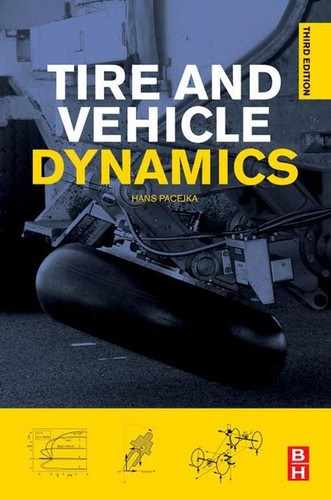Index
Note: Page numbers followed by f indicate figures, t indicate tables and b indicate boxes.
A
Abe, 16
ABS braking, 385–394
Adhesion, 79–80
Aerodynamic drag, 514
Aligning stiffness, definition, 5–6
Aligning torque, definition, 3
Axle cornering stiffness, 9–12
Axle side force, 11
B
Badalamenti and Doyle, 478
Bayer, 506–507
Belt segments, 583
Berritta, 506–507
Berzeri, 426
Biral, 507
Brake lever arm, 460–462
Breuer, 506–507
Brockman and Braisted, 458–459
Bruni, 455
Böhm, 88–90
C
Camber angle, 4, 70, 74–75, 77, 79, 109–110, 121, 155, 160, 171, 175–176, 192, 201, 332, 344–346, 427, 445, 513, 515–516, 519, 544–545, 552, 559–560, 567
Camber reduction factor, 126–127
Capsize mode, 531
Carcass distortion, 75
Characteristics, cf. tire characteristics
Characteristic speed, 25–26
Cheli, 455
Clark, 458
Cleat, 487–493
Combined slip with Fx as input, 163–165
Composite slip, 175
Constitutive relations, 453–462
Contact width, 116
Cornering force, cf. side force
loss (side force), 359
Cornering stiffness, definition, 5–6
Cossalter, 507
Curvature factor, 166–167
Cutoff frequency, 233–237
D
Damping:
motorcycle steer, 524
shimmy, 291–292
tire, 454
vehicle handling, 28
Davis, 478–479
Delft-Tire, 588
Differential equations:
- with carcass compliance, 415–417
string approximations, 253–255
Dijks, 178–179
Dugoff, 82
E
Effective rolling radius, 63, 69, 77, 156, 201, 344, 348, 367–370, 459, 461–462, 487–493, 498–499, 618
Eigenvalues:
vehicle handling, 28
Empirical model, 82
Equations of motion:
braked wheel system, 382
car-trailer, 53–57
motorcycle, 520–529
rigid belt, 446
shimmy, 294
steering vibrations, 381
F
Fancher, 82
Finite Element Model, 478
Forissier, 171
Four wheel steer, 35f
Frank, 88
Frequency response:
align. torque (SWIFT), 236
- and approximations, 243f
braked wheel, 109–110
lateral force (SWIFT), 237
longitudinal force (single point), 372–373
steering vibrations, 379–385
string model, 224–225
string with approx. dynamics, 272
SWIFT (zero belt mass), 410–411
vehicle handling, 32
Fritz, 214
G
Geometric filtering, 475
Gillespie, 16
Goncharenko, 256
Gong, 478
Gough, 476
Green function, 84
Guan, Dihua, 84
Guntur, 390–391
H
Handling experiments, 598
Hasegawa, 506–507
Ho and Hall, 214
HSRI (UMTRI), 82
Human rider model, 506
Hysteresis, 366–367
I
Iffelsberger, 506–507
Inclination angle, cf. camber angle
Influence function, 84
Instability:
J
Jansen, xiv, 507
Julien, 88
K
Karlsruhe University of Technology, 569–572
Katayama, 507
Kobiki, 468
Kooijman, 507
Kortüm, 16
L
Laerman, 214
Lafon, 171
Lagrange’s equations, 17
Lateral acceleration response, 34
Lateral c.g. offset (motorcycle), 550
Lateral force, cf. side force
Lateral slip, 67
Lateral slip stiffness, cf. cornering
stiffness
Lateral stiffness
suspension, 288
Lee, 191–192
Limebeer, 506–507
Lippmann, 476
Longitudinal force, definition, 3–4
Longitudinal slip stiffness, definition, 5–6
Lugner, xiv, 16
M
Magic Formula, 7, 82, 150–154, 165–206, 330, 335, 387, 404–406, 415, 424, 426–435, 441, 449–450, 452, 517–519, 565, 587–588
Magic Formula with turn slip, 183–188
Mastinu, 84
MATLAB, 611
Meier-Dörnberg, 214
Meijaard, 507
MF-Tire, 588
Milliken Research Associates, 51
Moment method, 51–53
Motorcycle dynamics, 505–566
Motorcycle tire force/ and moment, 202–206
Mousseau, 478
N
Natural frequencies:
vehicle handling, 30
Neutral steer, 25
Neutral steer point, 24
Nishimi, 507
Non-dimensionalisation, 552
Non-holonomic constraint, 523
Non-steady state, 211–286
Nonuniformity, 366–378
Nyquist plot:
and approximations, 247f
- with gyroscopic couple, 270
string model, 215–240
string with approx. dynamics, 274
SWIFT (with zero belt mass), 431
O
Olley, 288
Optimization, 589
P
Parameters Mag.F../SWIFT, 613–625
Parking maneuver, 436–444
Pevsner, 16
Phase plane, 46f
Plöchl, xvi
Pneumatic trail, 6, 27–28, 35, 43–44, 95, 103–105, 103f, 136–137, 136f, 165, 169–170, 227, 261, 263, 517
Pneumatic trail, definition, 5–6
Point of intersection, 62–63
Pothole response (SWIFT), 503–504
Pure slip, 5
R
Radial stiffness, 478–480
Regression technique, 168
Relaxation length:
- with carcass compl., 398f
contact patch model, 416f
vs normal load, 517
vehicle handling, 22
Rise time, 31
Road camber, 487
Rotation transformation, 511–512
S
Savkoor, 88
Scaling factors, 178–179
Self aligning torque, cf. aligning torque
Self-excited oscillations, 287–288
Shang, Jin, 84
Shape factor, 166
Sharpness factor, 168f
Side force, definition, 2
Side force steer, 9–10
Side slip, definition, 2
Similarity modelling method, 161–162
Single point approximations
fully non-linear, 353
Single track vehicle, 611
Slip components, 67
Slip radius, 63
Slip ratio, cf. longitudinal slip
Speed of revolution, 66
Stability:
car-trailer, 53–57
motorcycle, 529–538
vehicle handling, 16–58
Standing waves, 458–459
State space, 323–324
Steady-state response:
string model, 215–240
Steering vibrations, 379–385
Stepan, 291–292
Step response (tire):
motorcycle, 529–538
single point model, 330
string model, 225–232
SWIFT (zero belt mass), 410–411
vehicle handling, 587
Synchronous oscillation, 325–328
System of axes, cf. axes system
T
Tandem rear axle, 43
Tandem ‘cam’ technique, 485–486
Teerhuis, 507
Tire characteristics (steady-state):
brush model, camber, 120f
brush model, spin, 119–120
example, 3–7
Magic Formula, 165–206
Magic Formula motor cycle, 207f
Magic Formula with turn slip, 183–184
nondimensionalised, 151f
similarity method, 150–165
spin, turn slip, 138
string with tread elements, 258–268
tread simulation model, 128–140
Tire models, 81–85
Tire pull, 195–196
Toe angle, 9
Torsional stiffness:
motorcycle, 535–536
Trailer, 53–57
Trajectory, 145–146
Transfer function:
string model, 228
string with tread elements, 258
Transient tire behaviour, 385
Tread compliance, 130
Tread simulation model, 128–140
Turning, 112–127
U
Unbalance, 325–327
Understeer at braking, 49–50
V
Vehicle handling, 16–58
Vehicle handling experiments, 611
Vehicle slip angle response, 31–32
Vehicle stability, cf. stability
Volvo, 165
W
Weave mode, 529
Weir, 507
Wheel lock, 140–147
Whipple, 506
Willumeit, 84
Wind-up oscillations, 397–400
Winkler, 43
Wisselman, 506–507
Wobble mode, 531
Y
Yaw velocity response, 22–23
Z
..................Content has been hidden....................
You can't read the all page of ebook, please click here login for view all page.
